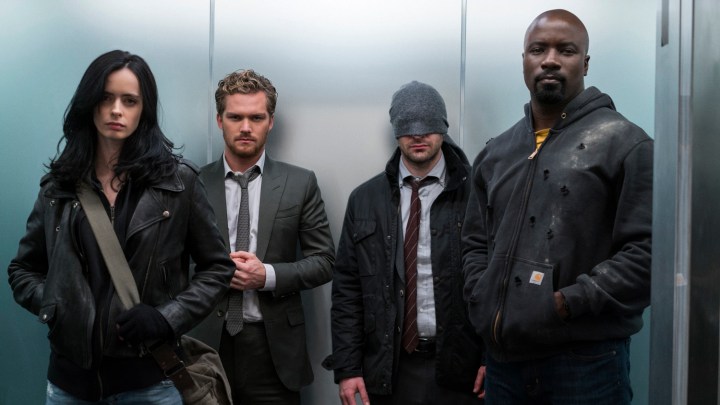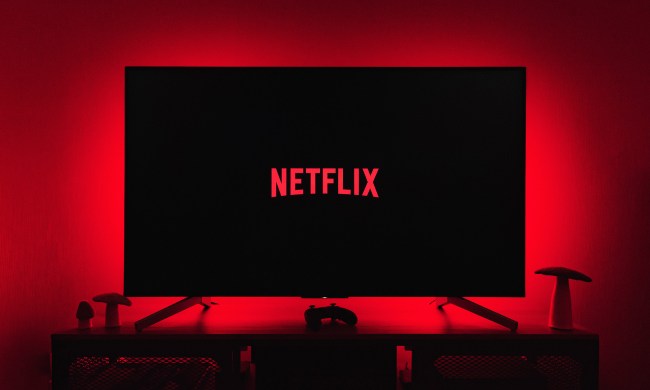
I didn’t expect to miss Marvel’s gritty Netflix heroes as much as I do, but here we are.
After 13 seasons of generally great television, the interconnected adventures of Daredevil, Jessica Jones, Luke Cage, Iron Fist, The Punisher, and their supporting cast of allies and enemies have seemingly shifted into the past-tense. A casualty of the changing landscape in the streaming video environment, this ambitious experiment ended not with a bang, but a whimper, as the third, lame-duck season of Jessica Jones debuted June 14, long after the series’ fate was sealed.
It’s a shame, really, because the Marvel-Netflix partnership deserved a send-off more befitting its legacy.
First announced back in 2013, the plan to release four solo superhero series that would later merge into a team-up series that brought the casts together was nothing short of groundbreaking.
Sure, Marvel had already accomplished a similar feat with The Avengers, but television was another matter altogether. Not only would Marvel’s Netflix universe have a massive number of intermingling characters across four TV shows, but it would also be set within the greater Marvel Cinematic Universe, which was already six movies deep at that point and only getting deeper.
On top of all of that, the shows promised to offer a gritty, mature spin on the MCU that simply didn’t exist at that point. Characters would drink, curse, and engage in the sort of brutal fights and casual sex that had — up to that point — seemed forbidden in Disney’s kid-friendly superhero universe.
Basically, if it didn’t have the might of Disney, Marvel, and Netflix behind it, no one would have believed it would work — and even with those powerful brands supporting it and a $200 million investment, there were still plenty of doubters.

Pundits speculated that the “dark” shows wouldn’t work within the family-friendly MCU, or that the interconnected-universe format that worked on the big screen wouldn’t translate to TV, or that Disney and Netflix were simply too big to cooperate effectively.
But succeed it did, with the first season of Daredevil blowing critics and Netflix subscribers away with its compelling introduction of the titular, blind vigilante, brilliantly portrayed by Charlie Cox.
More critically acclaimed series followed, and the mutually beneficial arrangement that gave Netflix a piece of one of Hollywood’s biggest franchises and Disney a prominent place on the industry-leading streaming platform soon became a match made in media heaven. That it managed to do so without any Hollywood A-listers in features roles only made its success that much more impressive.
In hindsight, it’s easy to downplay the importance of Marvel’s deal with Netflix as a partnership that was too good to last, but in reality, it just might have been one of the best decisions each company made in recent years — and one that changed the streaming environment dramatically.

Along with the aforementioned mutual benefits of the arrangement for Netflix and Disney, the shows reaffirmed the depth and potential of the Marvel Comics library of stories and characters. More so than even Iron Man, the heroes of Marvel’s Netflix-verse were relatively unknown (or poorly introduced) commodities outside the comics world before they made their way to streaming.
The massive popularity of these former D-List heroes also makes it increasingly likely we haven’t seen the last of Jessica Jones, Daredevil, or Luke Cage on one screen or another. And just as Iron Man and Guardians of the Galaxy proved that Marvel’s lesser-known characters can hold their own on the big screen, shows like Daredevil and Jessica Jones proved that TV — particularly, streaming platforms — can be just as effective for telling stories that bring out the best in Marvel’s heroes and villains.
The success of Marvel’s Netflix shows made it abundantly clear that a streaming platform was not just a viable host for a project of MCU proportions, but likely the best possible place for such a universe to call home. By having Daredevil, Jessica Jones, and the rest of Marvel’s “street-level” superheroes on Netflix, their adventures weren’t subject to the limitations of broadcast programming and typical network TV budgets, and could be developed according to the needs of the story instead of network guidelines.
The fact that years later, Disney was even willing to consider shows based on low-profile characters like Falcon and Winter Soldier, as well as Wanda Maximoff and Vision, for its upcoming streaming service, Disney Plus, likely has a lot to do with the success of The Defenders and Jessica Jones on Netflix. Even outside of the MCU, it’s easy to see how Disney’s investment in interconnected, canonical Star Wars shows for Disney Plus like The Mandalorian and the Rogue One prequel series was influenced by the performance — and reception to — Marvel’s spun-off superhero universe on Netflix.

Looking back on the deal with Netflix, the Marvel shows that came out of that arrangement look increasingly like a wildly successful test run for everything that followed.
And where Disney has applied the lessons it learned to its own, soon-to-debut streaming service, Netflix seemingly learned just as much from the experience.
The company is investing heavily in new, original properties that it can develop while simultaneously nurturing the expanding universes of its most popular shows, like Stranger Things. It’s also devoting plenty of time and resources to the genre properties it options and develops from other media and the wins that emerged from that attention have been big ones, with The Umbrella Academy and The Haunting of Hill House prime examples of two recent standouts.
Would we have those shows if Marvel and Netflix never buddied up for Daredevil and The Defenders? It’s anyone’s guess, really, but there’s a strong argument to be made that seeing the company’s initial investment in the MCU pay off made going all-in on fresh genre projects aimed at mature audiences a lot more appealing.
Sure, you can call the dissolution of Marvel’s deal with Netflix an example of something that was too good to last, but given all of the ways the streaming landscape has changed since the Netflix-verse first took form, we should also give credit where it’s due.
In the end, Daredevil, Jessica Jones, Luke Cage, The Defenders, The Punisher — and, yes, even Iron Fist — delivered on a promise that seemed too ambitious at the time, but succeeded despite the odds and changed what we expected from streaming TV.
Netflix and Disney’s collaboration gave us a darker version of the MCU, but its success made the future of streaming a lot brighter.



